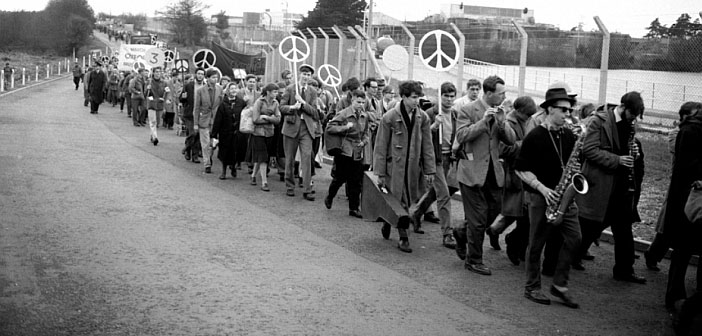This is the introduction to Kate Hudson’s new book, CND at 60: Britain’s most enduring mass movement, covering six decades of the Campaign for Nuclear Disarmament – from the mass protests at Aldermaston and Greenham Common, to its central role in post 9/11 anti-war campaigning. Available to buy here…
In 1945, the United States Air Force dropped atomic bombs on the Japanese cities of Hiroshima and Nagasaki with tragic and devastating consequences. Hundreds of thousands of people died, many instantaneously, others soon after from burns and shock, and yet more from the impact of radiation in the months and years that followed. By 1950, an estimated 340,000 people had died as a result of the two bombs.The impact of nuclear weapons – in both human and environmental terms – is widely recognised. A nuclear war would kill millions, perhaps destroying the entire human race. The radioactive fallout would render parts, if not all, of the planet uninhabitable. There would be no place to run to, no place to hide; in the event of a nuclear war, you may escape the blast but you cannot shut the door on radiation. It will poison and destroy, bringing sickness, cancers, birth deformities and death.
The consequences of nuclear weapons are widely understood by governments across the globe. So it seems incomprehensible that, over 70 years after the atomic bombs were dropped, nuclear weapons still exist – and that some political leaders still contemplate their use. Today, in the region of 15,000 nuclear weapons are stockpiled – enough to destroy human civilisation and the world as we know it many times over. The US alone has almost 7,000 nuclear warheads. Britain has over 200 nuclear warheads; this perhaps seems small in comparison, but each of Britain’s warheads has eight times the explosive power of the bomb dropped on Hiroshima. That is a phenomenal killing power – potentially 320 million people dead as a result of British nuclear weapons alone.
To make matters worse, political developments globally have been such over the past few years that there is an increased danger of the use of nuclear weapons. But contrary to what our government here in the UK would have us think, the danger does not come primarily from rogue states, terrorists or ‘non-state actors’. The people developing scenarios for the use of nuclear weapons are the existing nuclear weapons states, all of which are modernizing their nuclear weapons systems. This constitutes a dangerous escalation that could have unthinkable consequences for every one of us. But we are also aware that at the same time the majority of the global community is pushing for nuclear abolition – most notably through the UN’s nuclear weapons ban treaty. It is vital for the very future of humanity that this initiative is successful and we can all play a part in that process. In particular, here in the UK we have a responsibility to bring our own government on board.
For sixty years, the Campaign for Nuclear Disarmament, or CND, has inspired, led and organised – and no doubt infuriated and annoyed! – many hundreds of thousands of people, and has contributed to changes in politics and society that have shaped the lives of millions. It has been in the leadership of the largest popular mobilisations in every generation since World War II. It has been remarkable for its flexibility and dynamism, embracing methods as diverse as vigils, lobbying, mass demonstrations, raising issues in elections, human chains, peace camps, nonviolent direct action, theatre, letter writing: education, leafleting, street stalls, poetry and art, festivals, die-ins (lying on the ground, symbolising death), petitioning, walks, music, fasts, and a host of other imaginative forms of work. It has opposed all nuclear weapons from Polaris to Trident, and before and beyond; it has campaigned against wars where nuclear weapons may be used and against illegal wars that destroy the framework ofinternational law; against weapons in space, NATO, illegal preemptive attacks; nuclear power, nuclear waste transportation, the militarisation of Europe, the use of radioactive ‘depleted’ uranium in conventional weapons; the waste of spending on arms and much more. It champions a world of peace and social justice, free from the fear of nuclear annihilation.
The context of CND’s campaigns has changed continually: from the Cuban Missile Crisis to the war on Vietnam, from the height of the Cold War to detente, from the ‘evil empire’ of Ronald Reagan to the end of the Cold War, through the aggressive wars of Bush and Blair to the world of Trump and beyond. Whatever the context, CND has worked with others, in Britain and abroad, to find the most appropriate campaigning forms to bring our own anti-nuclear issues to the fore, to make them central in the current political agenda. That is not to say that the process of arriving at the right position to take, or the right campaigning initiative, has always been easy. On the contrary, argument and debate have been the hallmark of CND throughout its history. Disagreements have arisen over a range of issues: how much we should get involved in anti-war campaigning; how much direct action is appropriate; what stance we should take on nuclear power; what we think about parliamentary politics.
This is because only a movement open to different views can adapt and develop in an ever-changing world, and CND members are so passionate about their goals that they are determined to get it right. As a result CND has been able to play a leading role in virtually every peace campaign since its birth. CND’s most important asset has always been the accumulated experience of its members and its ability to consider different views through democratic debate. Many CND members have decades of experience in campaigning and participate fully in CND’s internal democracy and decision making processes. Our members do not hang back in expressing their views. Chairing a CND meeting has been described to me as being ‘like trying to herd cats’!
The purpose of this book is to tell the story of this extraordinary organisation, from its birth to the present day. It will explain the origins and development of the atomic bomb, why something so terrible was ever created, and the circumstances of its use by the US on Japan in 1945. The myth that dropping the bomb was necessary to end the war will be completely debunked and the tragic consequences of this criminal action will be explained. The book also explains the political events surrounding and shaping each phase of CND’s development and how anti-nuclear campaigning affected government policy and decision making (even if it wasn’t admitted at the time). Reading government documents and diaries years later, one can see how the pressure of public opinion and mass mobilisation really does have an impact, and each generation of CND has played a part in that. The banning of nuclear tests is one very important example; another is the abandoning of the neutron bomb (designed to kill people whilst leaving property intact) or Nixon’s pulling back from using nukes on Vietnam. There is a significant list of movement victories and we continue to work to add to this list.
In many respects, the history of CND is the history of post-World War II, told from the side of those fighting for humanity against the horror of war. It is the story of ordinary people’s struggles to shape a world without nuclear weapons and war, based on legality and morality; to make our governments responsive and accountable over our right to stay alive, our right to breathe air free of radioactive pollution, our right to say no to the indiscriminate killing of other peoples. CND has been most successful and effective when it has related directly to people’s most pressing concerns – linking our issues to the reality of what is going on in the world. Nuclear weapons are not the preserve of technological or military experts, in some specialist niche that isn’t relevant to ordinary mortals. Nuclear weapons are the concern of us all, for in them humankind has created something that could end our very existence – and governments will only shift on nuclear weapons policy when enoughof us demand change.
We continue to make this history and we continue with our struggle to bring our vision of the world into being.
Social Radicalisation. Kate Hudson reads from her book CND at 60
Published February 2018
CND at 60: Britain’s most enduring mass movement
 The inside story of the Campaign for Nuclear Disarmament, which has become a byword for protest and radicalism, shaping three generations and inspiring mass movements for peace across the globe. By CND General Secretary Kate Hudson.
The inside story of the Campaign for Nuclear Disarmament, which has become a byword for protest and radicalism, shaping three generations and inspiring mass movements for peace across the globe. By CND General Secretary Kate Hudson.

